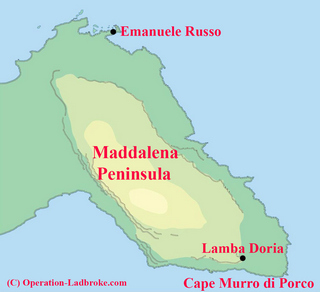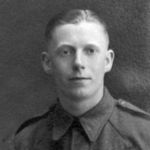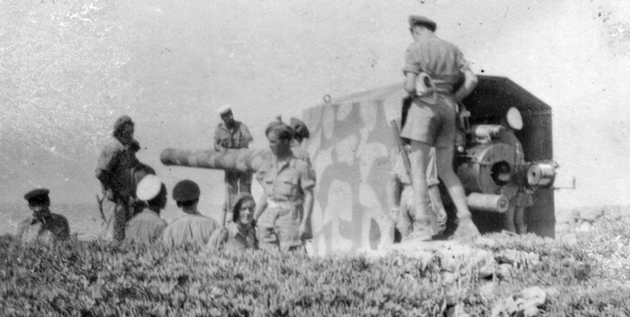
There is a well-known photograph of SAS troopers of Major Paddy Mayne’s Special Raiding Squadron (SRS), which shows them clustered around the turret of a heavy gun in an Italian gun battery. The scene has been said to show the SRS at the guns at Cape Murro di Porco, during the SRS attack on the battery in the small hours of D-Day in Operation Husky, the invasion of Sicily [story]. The battery, called Lamba Doria by the Italians, was strategically sited on the cape at the tip of the Maddalena Peninsula south of Syracuse. Here it had a direct line of sight to the anchorages of the invasion beaches, and its guns could wreak havoc among Allied troopships and landing craft.
“1540 Parties from S.R.S, [and] ships company landed for route march.”
“1500 Sqdn proceeds ashore to look over Cape Murro De Porco.”
Derrick Harrison was a lieutenant in charge of a section of 2 Troop of the SRS. In his book “These Men are Dangerous”, he wrote of the outing:
“We swarmed over Capo Murro di Porco where we had charged in with rifles and tommy-guns so few days before. Reminiscences were endless.”
“It was decided to take us over that day to Murro di Porco and let us wander over the peninsula individually, and have a look at all the familiar landmarks. […] It seemed strange to walk quietly beneath that blazing sun over an area where only a few days before, we had been tensed with excitement, and in which we had been suspicious of every building and every patch of cover. “
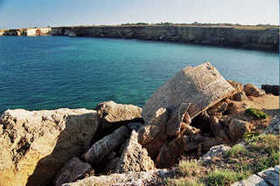
In addition to the sense of excitement and relief that the landscape was no longer a threat, there was also the ecstatic release of swimming, perhaps in the blue bay beside the Emanuele Russo battery. Harrison recounted how diving into the cool waters from a landing craft made him, momentarily at least, forget about the war.
Not Just Swimming
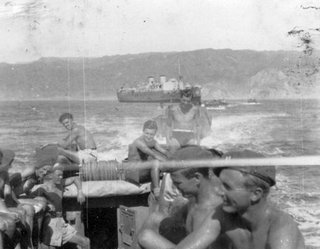
It seems everybody in the SRS could swim. Records in the SRS war diary show that swimming was on the Operation Husky training schedule every single day, along with the inevitable PT (physical training), which every man in the forces was familiar with. Unlike the SRS, however, PT in the rest of the Army did not usually include swimming.
“Following the usual custom of the [SAS] Regiment we managed to a certain extent to combine business with pleasure throughout this training. Each afternoon, over the ship’s loudspeakers blared the order, ‘S.R.S, prepare to embark’, upon which we would leap out of bed, throw down our cards, drinks or whatever it was and grab our swimming kit.”
“The navy would then take us to some chosen point on the coast where we would do our landing and then be fallen out for a swim. The boats would take us off again and we would follow the same procedure once more at some other point on the shore, until it was time to return to the ship. “
“The long endurance marches, the P.T., the assault courses and the regular swimming and sport had developed in them a pride in their bodies, a feeling of superiority over other men, which they were anxious to put to good account.”
Beside the Seaside
Swimming was in fact so good for morale that Eighth Army rest camps for battle-weary troops were set up for preference on the Mediterranean shore. The airborne soldiers of Operation Ladbroke, the glider assault on Syracuse that coincided with the SRS assault on Lamba Doria, went on just such a recuperation break to Hammamet in Tunisia after their ordeal.
Hammamet, still a beach resort to this day, was also chosen by the high and mighty. After the defeat of the Afrika Korps in North Africa, Air Marshall Arthur Coningham, commander of the Tactical Air Force during Operation Husky, requisitioned a luxury villa in Hammamet. Celebrity visitors included Vivien Leigh (then the world-famous star of the blockbuster movie “Gone with the Wind”), Winston Churchill and King George VI himself, who “enjoyed the bathing”.
“Even though we had cooled off in the sea, I can remember feeling very, very hot as the hot Scirroco wind blew over the top of the driver’s cabin as we returned, and I felt rather like a dried fig.”
Oppressive heat, with its risk of dehydration and heat stroke, was just one problem. Soldiers waiting in invasion ships at Suez found swimming in the harbour left them covered with oil. During an invasion rehearsal held in the Gulf of Aqaba, attended by the SRS and the main amphibious assault troops, armed guards were posted to protect swimmers against sharks and barracuda. Many men were cut by sharp coral.
Private Wilf Oldham, a Bren gunner in 1 Border Regiment, a glider-borne battalion, remembered the daily swimming trips to Sousse:
“You had to be very careful because there was a type of jellyfish, and if it rubbed up side of you, you got a very bad rash. But it was amazing to me, I’d only once seen the sea at Blackpool as a lad, and it was amazing to see how clear the seas were. “
Despite the inconveniences, it was the amazing aspects of swimming in the Mediterranean that men remembered most. Alexander Clifford was one of the best WW2 war correspondents, and a gifted writer. But despite his gifts, he claimed in his book “Three Against Rommel” that swimming daily in the Med near Alamein (shortly before the climactic battle of that name) left him struggling for words:
“The sheer physical pleasure of those bathes passes all description.”
For the benefit of the listeners at home in the UK, he explicitly linked this to the fighting spirit of their men. The families at home were doubtless cheered by this, and by the news of the invasion’s early successes, but not everyone who saw such sights was so sanguine.
Horror
“They are going to land without lights of any kind, in a half moon […] It requires the most skilful pilot to do it in a full moonlight. And this on top of a distant release with little margin. I am very pessimistic. […] Went swimming at the beach near Les Palmes, hundreds of ‘airbornes’ there. Watched their brown bodies and wondered how many would be smashed up in the thing described above.”
Wilf Oldham, the 1 Border Bren gunner, was one of those whose glider ditched in the sea off Sicily. He described the helplessness and terror of those hours. After his glider splashed down, it began filling rapidly with water. To his horror, he could not open the door to escape. Another man smashed it open with his rifle butt and climbed out. He was never seen again. The others got out, but their trial was only just beginning. Wilf remembers the horror:
“We had three or four men who couldn’t swim. One has to try and imagine how dreadful it was for these non-swimmers, a rough sea, strong wind and a high swell facing us all. […] Clinging to the wings and blowing up the lifebelts was all we could do. […] I don’t know if you’d call it a life belt. Nearest thing I could tell you, it was like a big sausage, you blew it up, and it sat across you and under your arms, and you tied it. It might have just about kept your head over water, but these men, as I said, couldn’t swim. It must have been, well it must have been hell in the water for them, because they must have been terrified. Over a period of time, we lost about another three men.”
Oldham remembered that there had been no effort beforehand to absolutely ensure that every man could swim, despite the fact it was known their gliders would be towed over miles of sea:
“About September 1942, all the battalion went to Ilfracombe, for three weeks special training. There was a big battle school there, and perhaps they’d had Sicily in mind, but one order was that when we came back, every man had to be able to swim. So before breakfast we were taken to the local baths, which they’d taken over. I could swim, I was a decent swimmer, but there were people that at the end of three weeks still couldn’t swim.”
Five days after D-Day in the waters off Syracuse, Harrison of the SRS may have briefly forgotten the war while swimming, but it was not for long. In the landing craft returning to Ulster Monarch after the expedition, he saw a body floating in the harbour. It was stripped to its underwear, just as many airborne men had done to help them survive the sea. It reminded him that only a few days before these waters, now calm, then gale-whipped, had drowned so many glider troops.
Captain Alex Muirhead was CO of the SRS mortars that night, and he remembered the ignored appeals of those men for the rest of his life. His son said that his father “used to hear their cries in the night as he tried to sleep, and this became a recurring nightmare to him in his final years.”
Long after D-Day, once the depleted ranks of 1 Border had gathered again back at their camp in Tunisia, this disaster bore some fruit. Orders were issued:
“All ranks will be taught to swim.”
Thanks to Paul Davis for permission to quote from Peter Davis’ book and to use photos from his album. “SAS Men in the Making” can be bought from the publisher here.
Many thanks also to Wilf Oldham, the Muirhead family, the editor of the Eagle magazine and the Army Flying Museum.

